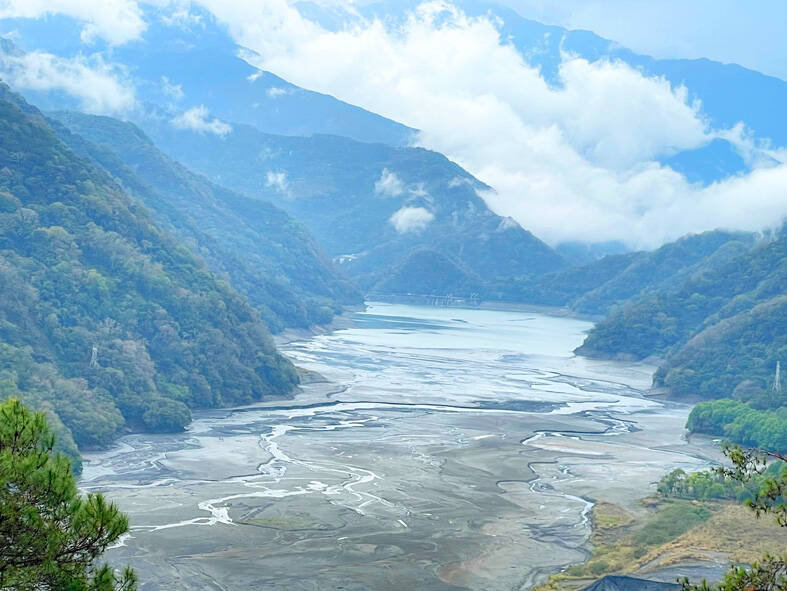The Water Resources Agency and the Chungshan Institute of Science and Technology conducted cloud seeding amid a cold front over the weekend in an effort to alleviate a drought.
Pyrotechnic flares were used over the Shihmen Reservoir (石門水庫) in Taoyuan and the Baoshan Second Reservoir (寶二水庫) in Hsinchu County on Saturday afternoon to induce rain, while ground-based cloud seeding generators were used on Saturday evening and yesterday near the two reservoirs, as well as the Mingde (明德) and Liyutan (鯉魚潭) reservoirs in Miaoli County, the agency said.
Areas north of Tainan, as well as eastern Taiwan and mountainous areas in the south, are likely to see rain amid the cold front, it added.

Photo courtesy of a reader
Water shortages continue to worsen in parts of Taiwan amid a severe drought, especially in the south, where reservoirs have received little to no rain since September last year.
The south’s two main reservoirs, Zengwen (曾文) and Nanhua (南化), have water storage rates of just 11 percent and 38 percent respectively, while the level at the Shihmen Reservoir is about 53 percent, the agency said.
Water conservation alerts in some municipalities were this month raised from “yellow” to “orange” under Taiwan’s four-color water alert system, meaning industrial water users would see a reduction in the amount of water supplied to them and households would face reduced water pressure.
Similar water controls would be employed in Kaohsiung starting on Thursday, the agency said.
Meanwhile, snow briefly fell on Yushan (玉山) yesterday, the latest date that snow has fallen on the mountain since records began in 1943, the Central Weather Bureau said.
Ice pellets were seen on the 3,952m peak at 6:40am, before snow fell between 7:05am and 7:15am, the bureau said.
Weather forecasters said that intensifying seasonal winds and moisture moving in from China created favorable conditions for snowfall on Yushan, where the mercury dropped to minus-0.2°C early yesterday.
No snow fell on Taiwan’s highest mountain during the most recent December-to-February winter season for the first time since records began 80 years ago.

TRAGEDY STRIKES TAIPEI: The suspect died after falling off a building after he threw smoke grenades into Taipei Main Station and went on a killing spree in Zhongshan A 27-year-old suspect allegedly threw smoke grenades in Taipei Main Station and then proceeded to Zhongshan MRT Station in a random killing spree that resulted in the death of the suspect and two other civilians, and seven injured, including one in critical condition, as of press time last night. The suspect, identified as a man surnamed Chang Wen (張文), allegedly began the attack at Taipei Main Station, the Taipei Fire Department said, adding that it received a report at 5:24pm that smoke grenades had been thrown in the station. One man in his 50s was rushed to hospital after a cardiac arrest

SAFETY FIRST: Double the number of police were deployed at the Taipei Marathon, while other cities released plans to bolster public event safety Authorities across Taiwan have stepped up security measures ahead of Christmas and New Year events, following a knife and smoke bomb attack in Taipei on Friday that left four people dead and 11 injured. In a bid to prevent potential copycat incidents, police deployments have been expanded for large gatherings, transport hubs, and other crowded public spaces, according to official statements from police and city authorities. Taipei Mayor Chiang Wan-an (蔣萬安) said the city has “comprehensively raised security readiness” in crowded areas, increased police deployments with armed officers, and intensified patrols during weekends and nighttime hours. For large-scale events, security checkpoints and explosives

PUBLIC SAFETY: The premier said that security would be tightened in transport hubs, while President Lai commended the public for their bravery The government is to deploy more police, including rapid response units, in crowded public areas to ensure a swift response to any threats, President William Lai (賴清德) said yesterday after a knife attack killed three people and injured 11 in Taipei the previous day. Lai made the remarks following a briefing by the National Police Agency on the progress of the investigation, saying that the attack underscored the importance of cooperation in public security between the central and local governments. The attack unfolded in the early evening on Friday around Taipei Main Station’s M7 exit and later near the Taipei MRT’s Zhongshan

A car bomb killed a senior Russian general in southern Moscow yesterday morning, the latest high-profile army figure to be blown up in a blast that came just hours after Russian and Ukrainian delegates held separate talks in Miami on a plan to end the war. Kyiv has not commented on the incident, but Russian investigators said they were probing whether the blast was “linked” to “Ukrainian special forces.” The attack was similar to other assassinations of generals and pro-war figures that have either been claimed, or are widely believed to have been orchestrated, by Ukraine. Russian Lieutenant General Fanil Sarvarov, 56, head